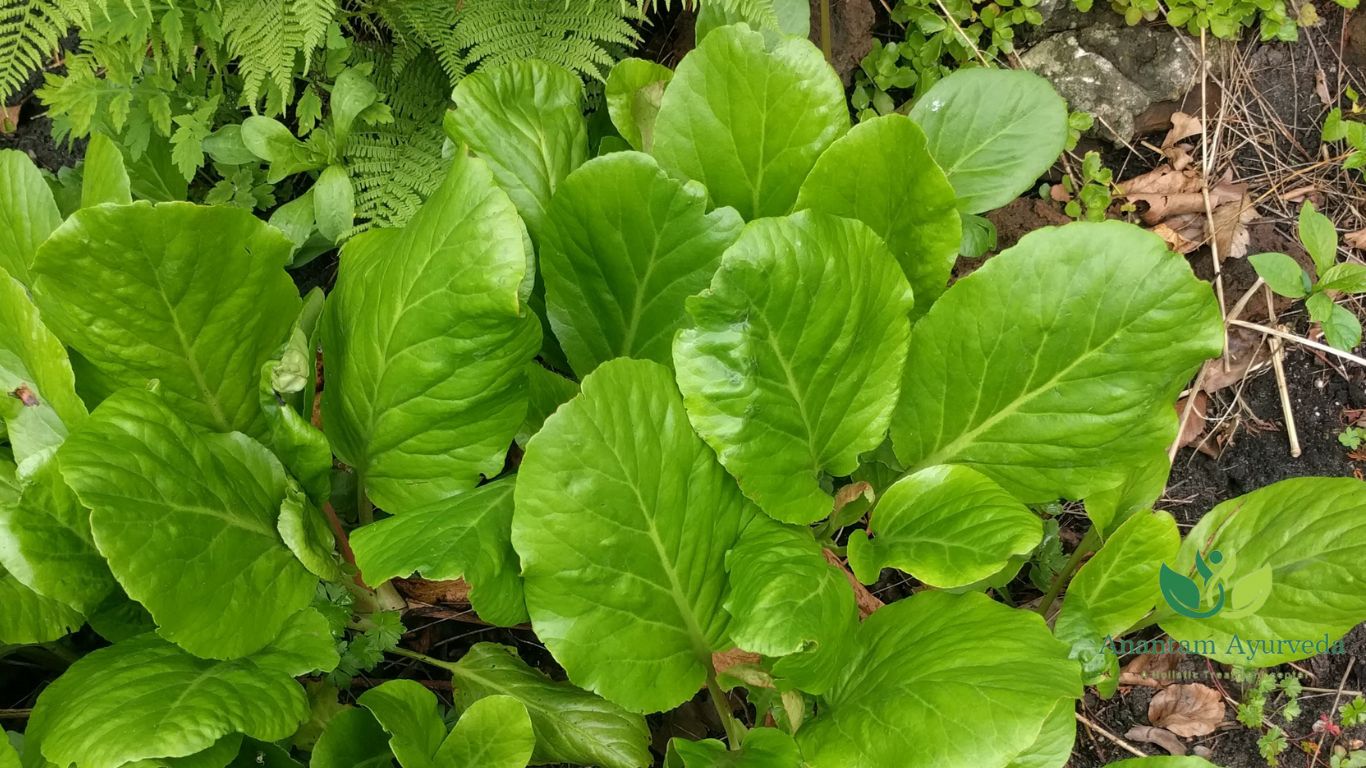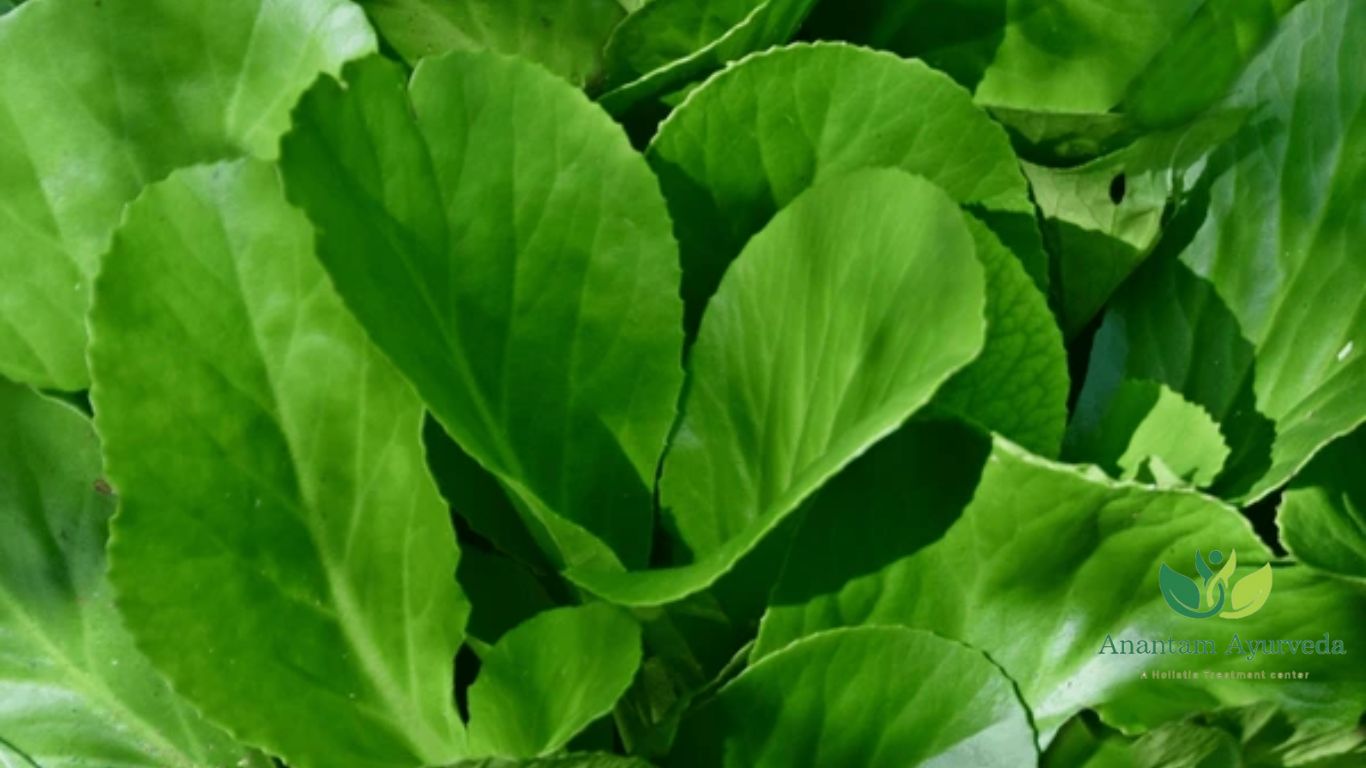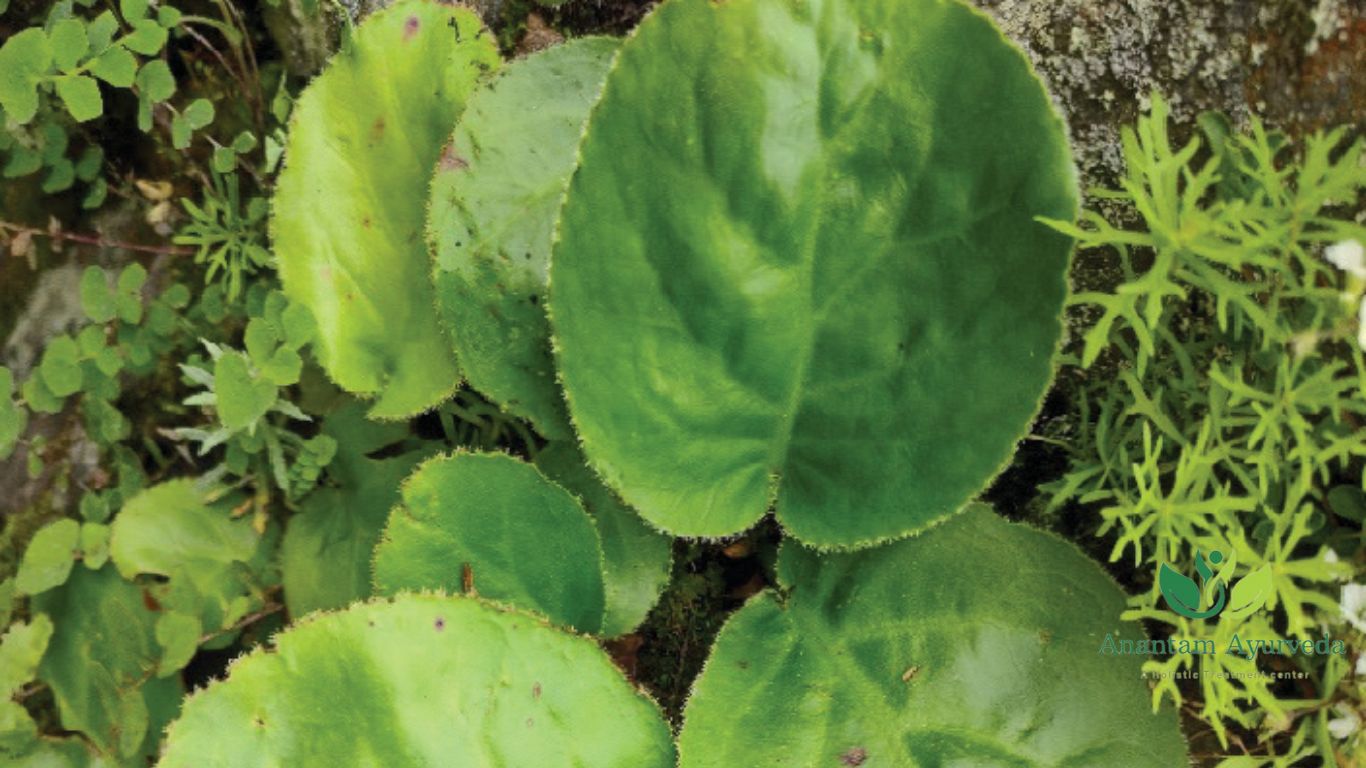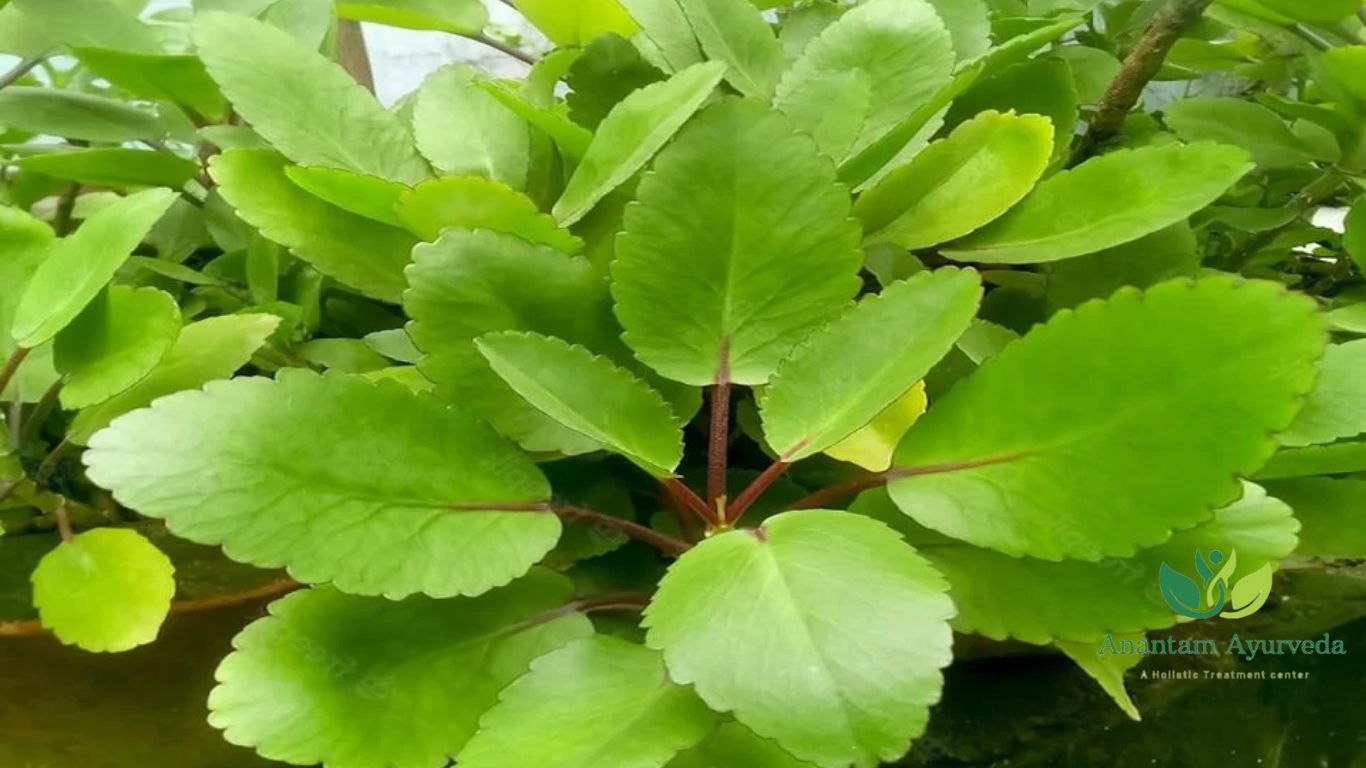Pashanabhed (Bergenia ligulata): Pashanbhed uses
Introduction of Pashanabhed
Pashanabhed (Bergenia ligulata) is a revered medicinal herb in Ayurveda, known for its stone-breaking properties, particularly in urinary disorders and kidney stones. The name Pashanabhed literally translates to “stone breaker”, highlighting its potential in dissolving and expelling urinary calculi. This powerful herb has been extensively used for centuries in Ayurvedic formulations for its diuretic, anti-inflammatory, and antimicrobial properties.
Botanical Description and Habitat of Pashanabhed
Bergenia ligulata, belonging to the Saxifragaceae family, is a perennial creeping herb found in the Himalayan regions at altitudes ranging from 900 to 3000 meters. The plant thrives in rocky terrain and shaded moist areas, growing between the wedges of mountain stones. It has thick rhizomes, fleshy leaves, and pink to purple flowers, with a reddish-colored root contributing to its medicinal properties.

Vernacular Names of Pashanabhed
Pashanabhed is known by different names in various languages:
- Hindi: Pakhanbhed, Patharchoor
- Gujarati: Pakhanbhed
- Bengali: Patharkuchi
- Sinhalese: Pahanabeya
- Arabic: Junteyenah
- Assamese: Patharkuchi
- Kannada: Pashanbhedi, Hittaga, Pasanaberu, Hittulaka
- Tamil: Sirupilai
- Punjabi: Kachalu
- Telugu: Kondapindi
- Malayalam: Kallurvanchi, Kallurvanni, Kallorvanchi
Sanskrit Synonyms of Pashanabhed
Pashanabhed has multiple Sanskrit synonyms that reflect its urolithic action and growing pattern:
- Ashmagna – Destroys renal stones
- Sailobheda – Penetrates through stones
- Upalabhedaka – Destroys the flat surface of stones
- Shilabheda – Grows between the wedges of stones
- Drushadbheda, Prasthara, Nagabheda
Botanical Description and Habitat of Pashanabhed
Bergenia ligulata, belonging to the Saxifragaceae family, is a perennial creeping herb found in the Himalayan regions at altitudes ranging from 900 to 3000 meters. The plant thrives in rocky terrain and shaded moist areas, growing between the wedges of mountain stones. It has thick rhizomes, fleshy leaves, and pink to purple flowers, with a reddish-colored root contributing to its medicinal properties.
Morphology of Pashanabhed
Plant Habit:
Pashanabhed is a perennial herb that grows in a dense, branched form.
Root:
-
Color: A rich red hue.
-
Thickness: Ranges from 2 to 5 cm.
Stem:
-
Structure: The stem is short, thick, fleshy, and sprawls across the ground.
Leaves:
-
Shape: Broad and ovate.
-
Dimensions: Between 12 and 25 cm across.
-
Attachment: The leaves are sessile, lacking a petiole.
-
Tip: Rounded edges.
-
Texture: The leaf surface is fringed with fine, short hairs.
Flowers:
-
Colors: Vary from white to shades of pink or purple.
-
Blooming Period: Primarily blooms during April and May.
-
Size: Each flower measures about 3 cm in diameter.
-
Arrangement: The flowers are arranged in a cymose panicle, with multiple branches emerging from a central point.
Fruits:
-
Type: A drupe, typically orange or red in color.
Valuable Part: Rhizome/Root:
-
Size: The dried rhizome is cut into pieces measuring up to 6 cm long and 1 to 2 cm in diameter.
-
Outer Surface: The rhizome’s surface is reddish-brown, wrinkled, or irregularly shriveled, with leaf remnants at the upper end and root scars beneath.
-
Inner Structure:
-
Bark: 2 to 3 mm thick.
-
Cambium Layer: Light-colored and distinct.
-
Wood: Encases a central, spongy pith.
-
-
Breaking Characteristics: When broken, the rhizome reveals a brick-red interior, but the process is challenging.
-
Scent: A faint but characteristic odor.
-
Taste: Bitter and slightly astringent.

Classical Categorization of Pashanabhed
Pashanabhed has been classified in various Ayurvedic texts:
- Charaka Samhita: Mutravirechaniya (Group of herbs useful in cleansing urine/bladder)
- Susruta Samhita: Viratarvadi
- Vagbhata: Viratarvadi
- Bhavaprakasha: Haritakyadi Varga
- Dhanwantari Nighantu: Guduchyadi Varga
- Kaiyyadeva Nighantu: Oushadi Varga
- Raja Nighantu: Parpatadi Varga
Phytochemical Constituents of Pashanabhed
Pashanabheda is rich in bioactive compounds, which contribute to its immense therapeutic benefits. The key phytochemicals include:
- Bergenin – Exhibits strong anti-inflammatory, diuretic, and antioxidant properties.
- Catechin – Known for its antioxidant and antimicrobial activity.
- Tannins – Aid in wound healing and antimicrobial effects.
- Flavonoids – Provide anti-inflammatory and immunomodulatory benefits.
Ayurvedic Properties of Pashanabhed
Pashanabhed is classified under Mutravirechaniya Dravyas (diuretic herbs) and is recognized for its ability to promote urine flow. The detailed Ayurvedic properties include:
- Rasa (Taste): Kashaya (Astringent), Tikta (Bitter)
- Guna (Quality): Laghu (Light), Snigdha (Oily)
- Vipaka (Post-digestive Effect): Katu (Pungent conversion after digestion)
- Veerya (Potency): Sheeta (Coolant)
- Effect on Tridosha: Tridosahara (Balances all three Doshas), Mootravirechaniya (Promotes urination)
- Prabhava (Special Action): Ashmari Bhedana (Crushes renal stones)
Health Benefits of Pashanabhed in Ayurveda
1. Effective in Treating Kidney Stones
Pashanabhed is primarily known for its ability to dissolve kidney stones and aid in their expulsion through urine. It acts as a diuretic and helps in breaking down calcium oxalate crystals, which are the main constituents of kidney stones.
2. Supports Urinary Health
Due to its diuretic properties, Pashanabhed is beneficial in treating urinary tract infections (UTIs), dysuria (painful urination), and frequent urination. It reduces inflammation of the urinary tract and prevents microbial growth.
3. Anti-Inflammatory and Analgesic Effects
Bergenin, a key component of Pashanabhed, exhibits anti-inflammatory properties, making it useful in managing rheumatoid arthritis, gout, and joint pain.
4. Helps in Respiratory Disorders
Pashanabhed is beneficial for bronchitis, asthma, and chronic cough due to its Kapha-reducing action. It helps in clearing mucus from the respiratory tract and alleviates congestion.
5. Promotes Wound Healing
Due to its astringent and antimicrobial properties, Pashanabhed is useful in treating wounds, ulcers, and skin infections. The tannins present in the herb help in rapid tissue repair and regeneration.
6. Regulates Blood Sugar Levels
Studies suggest that Pashanabhed exhibits anti-diabetic properties, helping in the management of blood glucose levels by enhancing insulin sensitivity.
7. Beneficial for Digestive Health
Pashanabhed acts as a gastroprotective herb, helping in the management of ulcers, gastritis, and indigestion. Its bitter properties stimulate digestive enzymes and improve gut health.

Natural Home Remedies of Pashanabhed
Relief for Dysuria and Backache
Pashanabhed Infusion for Urinary Comfort and Pain Relief
- Crush the whole plant into a coarse powder.
- Add one tablespoon of this powder to a cup of hot water and let it steep.
- Once infused, macerate well and filter.
- Consuming this infusion alleviates dysuria, back pain, and even mild diarrhea.
Urinary Stones and Recurrent UTIs
Pashanabhed Decoction for Kidney Stones and Urinary Tract Infections
- Take coarse powder of Pashanabheda and prepare a herbal decoction.
- Dosage: 40-50 ml twice or thrice daily for a week.
- Regular use dissolves kidney stones and prevents frequent urinary tract infections.
Traditional Kashaya Preparation:
- Boil 1 tablespoon of powder in 2 cups of water until reduced to 1 cup.
- Strain and drink warm.
Natural Relief for Teething Discomfort
Soothing Pashanabhed and Honey Application
- Mix fine powder of Pashanabheda with pure honey.
- Gently massage the mixture onto the gums during teething.
- This natural remedy reduces pain and swelling, providing relief for infants.
Managing Phosphaturia and Spermatorrhea
Coconut Water-Infused Herbal Paste
- Take fresh Pashanabhed leaves or root and blend with coconut water.
- Prepare a fine paste or extract juice.
- Dosage: 10-15 ml twice daily.
- This treatment regulates phosphaturia and addresses spermatorrhea, enhancing urinary and reproductive health.
Support for Women’s Health: Leucorrhoea and Haematuria
Pashanabhed and Gokshura Decoction for Urogenital Wellness
- Combine equal parts of Pashanabheda and Gokshura (Tribulus terrestris).
- Prepare a decoction using the classical Kashaya method.
- This powerful herbal blend reduces leucorrhoea, haematuria, and burning urination.
For individuals seeking affordable, natural alternatives to treat kidney stones and urinary ailments, Ayurvedic solutions such as Pashanabheda offer effective and holistic healing.
Traditional Ayurvedic Formulations Containing Pashanabhed
1. Chandraprabha Vati
A well-known Ayurvedic formulation for urinary disorders, kidney stones, and diabetes.
2. Pashanabhed Kashaya
An herbal decoction used for treating urinary tract infections and kidney stone dissolution.
3. Gokshuradi Guggulu
A classical preparation beneficial in treating kidney disorders, urinary infections, and inflammation.
4. Varunadi Kwath
An effective herbal formulation used in the treatment of renal calculi and dysuria.
How to Use Pashanabhed?
1. Pashanabhed Powder
- Dosage: 1–3 grams per day with warm water or honey.
- Usage: Helps in kidney stones, urinary disorders, and respiratory issues.
2. Herbal Decoction (Kashaya)
- Preparation: Boil 5 grams of Pashanabhed root in 250 ml of water until it reduces to half.
- Dosage: Consume twice daily for urinary tract health.
3. Pashanabhed Juice (Swarasa)
- Extract the fresh juice from its leaves or roots.
- Dosage: Take 10-15 ml for kidney and digestive health.
Precautions and Side Effects of Pashanabhed
While Pashanabhed is generally safe for consumption, some precautions must be taken:
- Avoid excessive use, as it may lead to electrolyte imbalance.
- Not recommended for pregnant and lactating women without medical advice.
- Patients with chronic kidney disease should consult a physician before use.
Scientific Research and Modern Validation of Pashanabhed
Several scientific studies validate the traditional claims of Pashanabhed:
- A study published in the Journal of Ethnopharmacology highlighted its diuretic and anti-urolithic properties, confirming its effectiveness in dissolving kidney stones.
- Research in the Indian Journal of Pharmacology demonstrated its antimicrobial properties against UTI-causing pathogens.
- Clinical studies suggest its role in preventing recurrent kidney stones, making it a safe and natural alternative to synthetic diuretics.
Substitutes for Pashanabhed
Several plants are used as substitutes for Pashanabhed in different regions:
- Aerva lanata Juss – Whole herb
- Didymocarpus pedicellatus R.Br – Root
- Coleus amboinicus Benth – Root
- Bergenia ciliata – Root
- Bergenia stracheyi – Root

Controversy Surrounding Pashanabhed
Pashanabhed, a well-known herb in Ayurvedic medicine, has long been at the center of scientific and traditional debates due to its identification, authenticity, and standardization. The controversy arises due to the multiple plant species identified as Pashanabhed across different regions of India. This lack of uniformity has significant implications for pharmacological efficacy, safety, and regulatory compliance.
Botanical Discrepancies and Taxonomic Confusion
One of the primary challenges with Pashanabhed is the ambiguity in its botanical classification. Several plant species are referred to as Pashanabhed in various Ayurvedic texts and local traditions. The most commonly identified species include:
- Bergenia ligulata (Syn: Saxifraga ligulata) – Considered the authentic Pashanabheda in classical Ayurveda.
- Aerva lanata – Commonly used in South India for the same therapeutic purposes.
- Rotula aquatica – Often substituted for Pashanabheda in some regions.
- Didymocarpus pedicellata – Another plant sometimes mistaken for Pashanabheda.
These discrepancies lead to confusion in Ayurvedic formulations, as different plant species may have varying chemical compositions and medicinal properties.
Pharmacological Implications of Variability
Since different plant species are marketed as Pashanabheda, the bioactive compounds and therapeutic efficacy can vary significantly. Bergenia ligulata contains active constituents such as bergenin, tannins, flavonoids, and saponins, which contribute to its known antiurolithic, diuretic, and anti-inflammatory properties. On the other hand, Aerva lanata is rich in alkaloids, flavonoids, and glycosides, offering similar yet distinct benefits.
This variation raises concerns regarding standardization in Ayurvedic formulations, affecting not only the efficacy of herbal medicines but also their potential side effects. Patients consuming inconsistent formulations may not receive the expected therapeutic benefits, leading to distrust in Ayurvedic medicine.
Quality Control Challenges
The lack of a standardized definition for Pashanabhed creates regulatory hurdles in quality control and pharmacopoeial guidelines. Without a uniform standard, Ayurvedic practitioners and manufacturers struggle to ensure batch-to-batch consistency, resulting in potential safety concerns.
To address these issues, several regulatory bodies, including the Ayush Ministry and the Pharmacopoeia Commission for Indian Medicine & Homoeopathy (PCIM&H), have emphasized the need for botanical authentication, DNA barcoding, and chromatographic fingerprinting for Ayurvedic herbs like Pashanabhed.
Regional Preferences
Pashanabhed is widely used in different regions of India, and local traditions dictate which species are preferred. Some examples include:
- Himalayan regions – Bergenia ligulata is the predominant choice due to its availability in rocky terrains.
- South India – Aerva lanata is more commonly used as Pashanabhed in Siddha medicine.
- Western Ghats – Rotula aquatica is often utilized in folk medicine for kidney-related ailments.
Such regional preferences further complicate the issue of standardization and authenticity in Ayurvedic practice.
Scientific Investigations
Several scientific studies have been conducted to validate the therapeutic claims of Pashanabheda. Notable research findings include:
- A study on Bergenia ligulata demonstrated its antiurolithic activity, confirming its traditional use in kidney stone treatment.
- Aerva lanata has been researched for its diuretic and hepatoprotective properties, further supporting its medicinal applications.
- Comparative phytochemical analyses have revealed significant differences in the composition of these species, reinforcing the need for precise botanical identification in Ayurvedic formulations.
The Need for Standardization
The controversy surrounding Pashanabhed highlights the urgent need for standardization and scientific validation in Ayurvedic medicine. Establishing a single, universally accepted botanical source for Pashanabheda is crucial to ensuring consistent therapeutic efficacy and patient safety. Future research should focus on advanced phytochemical studies, genetic analysis, and clinical trials to achieve a definitive classification.
As Ayurveda continues to gain global recognition, maintaining stringent quality control measures will enhance the credibility and effectiveness of traditional medicine. Addressing the botanical confusion surrounding Pashanabheda is a significant step toward achieving this goal.

Conclusion
Pashanabhed (Bergenia ligulata) stands as a remarkable herb in Ayurveda, offering a natural remedy for kidney stones, urinary disorders, respiratory issues, and inflammation. Its potent medicinal properties, backed by traditional knowledge and scientific research, make it a valuable herbal solution for numerous health concerns. Integrating this powerful herb into daily wellness routines can significantly enhance overall health and well-being.
Frequently Asked Questions About Pashanbhed
Q. How should Pashanbhed be stored?
To maintain its potency, Pashanbhed rhizomes should be packed in gunny bags and stored in a cool, dry place to prevent moisture damage.
Q. What are the different ways to use Pashanbhed?
Pashanbhed is available in various forms, including tablets, powders, and capsules. It is advisable to use it under the supervision of a qualified Ayurvedic practitioner.
Q. Can Pashanbhed help reduce fever?
Yes, Pashanbhed possesses antipyretic properties, which help induce sweating and normalize elevated body temperature. In Ayurveda, fever is often linked to an imbalance of Pitta dosha, and Pashanbhed helps balance all three doshas, especially Pitta, due to its cooling properties.
Q. How does Pashanbhed help with ulcers?
Pashanbhed has cytoprotective properties, which protect the mucosal wall from harmful toxins, preventing the formation of ulcers. It also helps improve digestion, reducing the risk of ulcers caused by Vata-Pitta imbalance and constipation.
Q. Can Pashanbhed help prevent malaria?
Yes, Pashanbhed has antiplasmodial properties, which inhibit the growth of malarial parasites, potentially reducing the risk of infection.
Q. Does Pashanbhed have antimicrobial benefits?
Yes, Pashanbhed contains phenolic and flavonoid compounds that inhibit microbial growth, making it effective against certain infections.
Q. What are the benefits of Pashanbhed for kidney stones (urolithiasis)?
Pashanbhed helps dissolve oxalate crystals, reducing the size of kidney stones due to its antilithic and diuretic properties. It also prevents stone recurrence by flushing out toxins from the urinary tract.
Q. Can Pashanbhed help relieve cough?
Yes, Pashanbhed has antitussive properties that help clear mucus from the respiratory tract, easing breathing and reducing cough. In Ayurveda, it balances Kapha dosha, preventing excessive mucus production.
Q. Can Pashanbhed help manage diabetes?
Although scientific evidence is limited, Pashanbhed may help lower blood glucose levels, making it beneficial for diabetes management.
Q. Is Pashanbhed a natural antioxidant?
Yes, Pashanbhed has free radical scavenging properties, protecting cells from oxidative stress and reducing the risk of chronic diseases.
Q. How should Pashanbhed powder be consumed?
For kidney and urinary issues, 1-3 grams of Pashanbhed powder can be taken once or twice daily with water. Always consult a healthcare provider before use.
Q. How is Pashanbhed used for kidney stones?
Pashanbhed is commonly taken as a powder, tablet, or decoction (Kashaya). The recommended dosage is 1-3 grams of powder once or twice daily or as prescribed by an Ayurvedic doctor.
Q. What are the medicinal uses of Pashanbhed tablets?
Pashanbhed tablets act as a herbal diuretic, helping increase urine flow and sodium excretion. They are beneficial for conditions such as hypertension, kidney failure, nephrotic syndrome, and urinary tract infections.
Q. Can Pashanbhed be used for skin burns and boils?
Yes, Pashanbhed has anti-inflammatory properties, making it useful for skin burns and boils. Applying its paste to the affected area can help reduce pain and swelling.
Q. Is Pashanbhed beneficial for teething problems in children?
Yes, Pashanbhed powder mixed with honey can be applied to a baby’s gums to ease teething discomfort and reduce gum irritation.
Q. Does Pashanbhed help in urinary tract infections (UTI)?
Yes, Pashanbhed is a natural diuretic that helps flush out toxins, reducing the risk of UTIs. Its antimicrobial properties also help combat bacterial infections.
Q. Can Pashanbhed be useful for liver disorders?
Although more research is needed, its diuretic and detoxifying properties may help improve liver function and aid in managing liver disorders.
Q. Does Pashanbhed have an effect on blood pressure?
Due to its diuretic action, Pashanbhed helps regulate blood pressure by promoting urine excretion, which reduces fluid retention.
Q. Can Pashanbhed be useful for digestive disorders?
Yes, Pashanbhed aids digestion, alleviates bloating, and helps manage constipation due to its purgative (Bhedana) properties.
Q. Is Pashanbhed safe for long-term use?
While Pashanbhed is generally safe when taken in recommended doses, long-term use should be monitored by a healthcare provider to prevent any potential side effects.
These FAQs provide scientifically backed and Ayurvedic insights into the benefits and usage of Pashanbhed (Bergenia ligulata). If you have any specific health concerns, consult a qualified Ayurvedic practitioner before use.
For more detailed information on Ayurvedic herbs, stay connected!
You can follow us on twitter, facebook, instagram & Google News

1 Comment